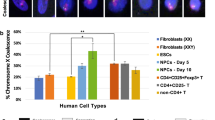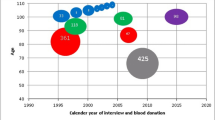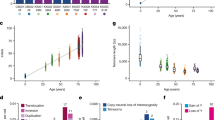Abstract
In mammals, X-chromosome dosage compensation is achieved by inactivating one X chromosome in female cells1. To test the hypothesis2 that genes on the silent X chromosome reactivate as a consequence of ageing, we examined the X-linked hypoxanthine phosphoribosyltransferase (HPRT) locus in 41 women who are heterozygous for mutations at this locus, leading to severe deficiency of the enzyme (Lesch-Nyhan syndrome3). We find that heterozygotes who are more than 10 yr old have an excess of HPRT+ skin fibroblast clones (59% rather than the 50% expected as a consequence of random X inactivation) but this excess does not increase with age. Further studies of eight of these heterozygotes show that the silent locus does not detectably reactivate spontaneously in culture, but only in response to treatment with 5-aza-2-deoxycytidine, a potent inhibitor of methylation. There is no age difference in the frequency of this reactivation as assayed by HATr clones, and a more sensitive autoradiographic assay shows only a twofold difference between young and old heterozy-gotes. Thus, age-related reactivation is not a feature of all X-linked loci, and may have species, tissue and locus-specific determinants.
This is a preview of subscription content, access via your institution
Access options
Subscribe to this journal
Receive 51 print issues and online access
$199.00 per year
only $3.90 per issue
Buy this article
- Purchase on Springer Link
- Instant access to full article PDF
Prices may be subject to local taxes which are calculated during checkout
Similar content being viewed by others
References
Lyon, M. F. Biol. Rev. 47, 1–35 (1972).
Wareham, K. A., Lyon, M. F., Glenister, P. H. & Williams, E. D. Nature 327, 725–727 (1987).
Lesch, M. & Nyhan, W. L. Am. J. Med. 36, 561–570 (1964).
Cattanach, B. M. Genet. Res. 23, 291–306 (1974).
Holliday, R. & Tarrant, G. M. Nature 238, 26–30 (1972).
Holliday, R. Expl Cell Res. 166, 543–552 (1986).
Holliday, R. Nature 327, 661–662 (1987).
Harris, M. Cell 29, 483–492 (1982).
Migeon, B. R., Der Kaloustian, V. M., Nyhan, W. L., Young, W. J. & Childs, B. Science 160, 425–427 (1968).
Migeon, B. R. Biochem. Genet. 4, 377–384 (1970).
Migcon, B. R. Am. J. hum. Genet. 23, 199–210 (1971).
Trainor, K. J. et al. in Mechanisms of Ageing and Development 27, 83–86 (1984).
Nyhan, W. L., Bakay, B., Connor, J. D., Marks, J. F. & Keele, D. K. Proc. natn. Acad. Sci. U.S.A. 65, 214–218 (1970).
Dancis, J. et al. Life Sci. 7, 587–591 (1968).
Albertini, R. J. & DeMars, R. Biochem. Genet. 11, 397–411 (1974).
Mohandas, T., Sparkes, R. S. & Shapiro, L. J. Science 211, 393–396 (1981).
Beggs, A., Axelman, J. & Migeon, B. R. Somatic Cell Genet. 12, 585–594 (1986).
Kaslow, D. C. & Migeon, B. R. Proc. natn. Acad. Sci. U.S.A. 84, 6210–6214 (1987).
Wolf, S. F., Jolly, D. J., Lunnen, K. D., Friedmann, T. & Migeon, B. R. Proc. natn. Acad. Sci. U.S.A. 81, 2806–2810 (1984).
Yen, P. H., Patel, P., Chinault, A. C., Mohandas, T. & Shapiro, L. J. Proc. natn. Acad. Sci. U.S.A. 81, 1759–1763 (1984).
Migeon, B. R. Nature 239, 87–89 (1972).
Wolf, S. F. & Migeon, B. R. Nature 295, 667–671 (1982).
Wolf, S. F. et al. Nucleic Acids Res. 12, 9333–9348 (1984).
Riggs, A. D., Singer-Sam, J. & Keith, D. H. in Biology and Biochemistry of DNA Methylation (eds Cantoni, G. L. & Razin, A.) 211–222 (Liss, New York, 1985).
Bird, A. P. Nature 321, 209–213 (1986).
Ruta Cullen, C., Hubberman, P., Kaslow, D. C. & Migeon, B. R. EMBO J. 9, 2223–2229 (1986).
Hannibal, M. C., Cullen, C. R., Kaslow, D. C., Davies, K. E. & Migeon, B. R. Am. J. hum. Genet. 39, A201 (1986).
Mullins, L. J., Veres, G., Caskey, C. T. & Chapman, V. Molec. cell. Biol. 7, 3916–3922 (1987).
Wilson, V. L., Smith, R. A., Mas, S. & Cutler, R. G. J. biol. Chem. 262, 9948–9951 (1987).
Fairweather, D. S., Fox, M. & Margison, G. P. Expl Cell Res. 168, 153–159 (1987).
Author information
Authors and Affiliations
Rights and permissions
About this article
Cite this article
Migeon, B., Axelman, J. & Beggs, A. Effect of ageing on reactivation of the human X-linked HPRT locus. Nature 335, 93–96 (1988). https://doi.org/10.1038/335093a0
Received:
Accepted:
Published:
Issue Date:
DOI: https://doi.org/10.1038/335093a0
This article is cited by
-
The X chromosome and sex-specific effects in infectious disease susceptibility
Human Genomics (2019)
-
Imprinted X inactivation maintained by a mouse Polycomb group gene
Nature Genetics (2001)
-
Evidence for gene silencing by DNA methylation in normal human diploid fibroblasts
Somatic Cell and Molecular Genetics (1995)
-
Evidence for erosion of mouse CpG islands during mammalian evolution
Somatic Cell and Molecular Genetics (1993)
-
At least two distinct epigenetic mechanisms are correlated with high-frequency ?switching? for aprt phenotypic expression in mouse embryonal carcinoma stem cells
Somatic Cell and Molecular Genetics (1992)
Comments
By submitting a comment you agree to abide by our Terms and Community Guidelines. If you find something abusive or that does not comply with our terms or guidelines please flag it as inappropriate.



